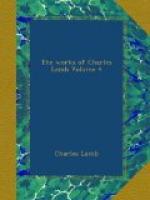I was pleased with the reply of a gentleman, who being asked which book he esteemed most in his library, answered,—“Shakspeare:” being asked which he esteemed next best, replied, “Hogarth.” His graphic representations are indeed books: they have the teeming, fruitful, suggestive meaning of words. Other pictures we look at,—his prints we read.
In pursuance of this parallel, I have sometimes entertained myself with comparing the Timon of Athens of Shakespeare (which I have just mentioned) and Hogarth’s Rake’s Progress together. The story, the moral, in both is nearly the same. The wild course of riot and extravagance, ending in the one with driving the Prodigal from the society of men into the solitude of the deserts, and in the other with conducting the Rake through his several stages of dissipation into the still more complete desolations of the mad-house, in the play and in the picture, are described with almost equal force and nature. The levee of the Rake, which forms the subject of the second plate in the series, is almost a transcript of Timon’s levee in the opening scene of that play. We find a dedicating poet, and other similar characters, in both.
The concluding scene in the Rake’s Progress is perhaps superior to the last scenes of Timon. If we seek for something of kindred excellence in poetry, it must be in the scenes of Lear’s beginning madness, where the King and the Fool and the Tom-o’-Bedlam conspire to produce such a medley of mirth checked by misery, and misery rebuked by mirth; where the society of those “strange bedfellows” which misfortunes have brought Lear acquainted with, so finely sets forth the destitute state of the monarch; while the lunatic bans of the one, and the disjointed sayings and wild but pregnant allusions of the other, so wonderfully sympathize with that confusion, which they seem to assist in the production of, in the senses of that “child-changed father.”
In the scene in Bedlam, which terminates the Rake’s Progress, we find the same assortment of the ludicrous with the terrible. Here is desperate madness, the overturning of originally strong thinking faculties, at which we shudder, as we contemplate the duration and pressure of affliction which it must have asked to destroy such a building;—and here is the gradual hurtless lapse into idiocy, of faculties, which at their best of times never having been strong, we look upon the consummation of their decay with




